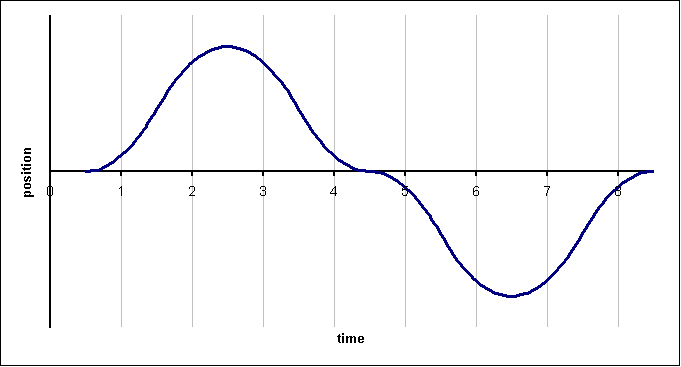Position Versus Time Graph
A plot of position versus time is often a useful diagrammatic representation of a kinematics problem.
GraphicalRepresentationofConstantVelocity"> Graphical Representation of Constant Velocity
SlopeandVelocity"> Slope and Velocity
The mathematical definition of velocity is equivalent to the formula for the slope of a position versus time graph. To see the utility of this correspondence, consider the following plots:
null null null
Consider the left plot. The abscissa is time, and the ordinate is position. This graph is giving the position of some object (called object A) as a function of time. Looking at the graph, we can see that for each second of time that elapses, the object changes its position by 2 meters. This is the same as saying that the slope of the left plot is 2 m / (1 s) or, more simply, 2 m/s. Object A, then, is moving with a speed of 2 m/s.
Contrast that with the middle plot. Object B is only changing its position by 1 meter every second. Thus, it is moving with a speed of 1 m/s.
Finally, look at the plot on the right. Object C is changing its position by 2 meters every second, and so it has a speed of 2 m/s. Note that objects A and C have the same speed. The graphs are different, however, because object C is moving in the negative direction.
That doesn't necessarily mean objects A and C are moving in different actual directions. Recall from lesson 1 that when we are looking at position data, we should always consider what coordinate system applies (does the positive x direction point east? west? north?...), and we haven't determined that for any of the graphs yet.
CheckYourUnderstanding"> Check Your Understanding
Suppose that all three of the plots describe objects moving on the same coordinate system. The positive direction of the system points east, and the negative points west. Try to describe the motions of the three objects in words, based upon what you have learned from the graphs.
Answer: There are many ways to describe the motion, but here are some important features. At the beginning of the motion, A and C are both at the same location, while B is 5 meters east of A and C. A begins moving east at 2 m/s, B begins moving west at 2 m/s and C begins moving east at 1 m/s. By the end of the motion (as plotted) A has caught B (at a position 10 m east of where A and C began). A and B are now 20 meters east of C.
GraphicalRepresentationofConstantAcceleration"> Graphical Representation of Constant Acceleration
ConcavityandAcceleration"> Concavity and Acceleration
Because of the similarity of the definitions of acceleration and velocity, acceleration can be thought of as the slope of a [velocity versus time graph], just as velocity is the slope of a position versus time graph. It might not be clear, however, that we can also see the effects of acceleration in a position versus time graph.
null
Consider the position vs. time graph shown above. If you were to lay a ruler along the curve of the graph at the origin, the ruler would have to be horizontal to follow the curve, indicating zero slope. Thus, the velocity is zero at the origin. As you follow the curve, however, the ruler would have to be held at a steeper and steeper angle (see the lines added in the graph below). The slope grows with time, indicating that the velocity is becoming more and more positive (the speed is increasing). This positive change in velocity indicates a positive acceleration. In calculus terminology, we would say that a graph which is "concave up" or has positive curvature indicates a positive acceleration.
null
"Acceleration"versusDeceleration"> "Acceleration" versus Deceleration
In everyday speech, we distinguish between "accelerating" and "decelerating". In physics, both situations are referred to as acceleration (which can be confusing). It is possible to give an exact definition of deceleration, however. Deceleration occurs when the velocity and the acceleration vectors have opposite directions. "Acceleration" in the everyday sense (speeding up) occurs when the acceleration vector and the velocity vector have the same direction. The two cases can be distinguished graphically.
GraphsShowing"Acceleration""> Graphs Showing "Acceleration"
null |
null |
positive acceleration |
negative acceleration |
|---|
Both the graphs that show "acceleration" have slopes that are steepening with time. The only difference is that one of the graphs has a steepening positive slope and the other has a steepening _negative slope.
GraphsShowingDeceleration"> Graphs Showing Deceleration
null |
null |
negative acceleration |
positive acceleration |
|---|
Both graphs showing "deceleration" have slopes that are approaching zero as time evolves. (Again, one has a negative slope and one has a positive slope.)
It is a very common misconception that a negative acceleration always slows down the object it acts upon. This is not true. It is important to note that a graph which has a negative slope approaching zero (slowing down) implies a positive acceleration, and a graph which has a negative slope that is steepening (speeding up) implies a negative acceleration. It may help you to remember that the concavity of the graph specifies the direction of the acceleration.
Check Your Understanding"> Check Your Understanding
By looking at the position versus time graph shown above, determine the following at each of the eight numbered instants of time:
A.) Is the object's position positive or negative?
B.) Is the object's velocity positive or negative?
C.) Is the object's acceleration positive or negative?
D.) Is the object speeding up (accelerating) or slowing down (decelerating)?
Solution
System, Interactions and Model: This exercise is a review of the definitions of position, velocity and acceleration. These concepts are used in several of the models in the hierarchy.
Answers:
